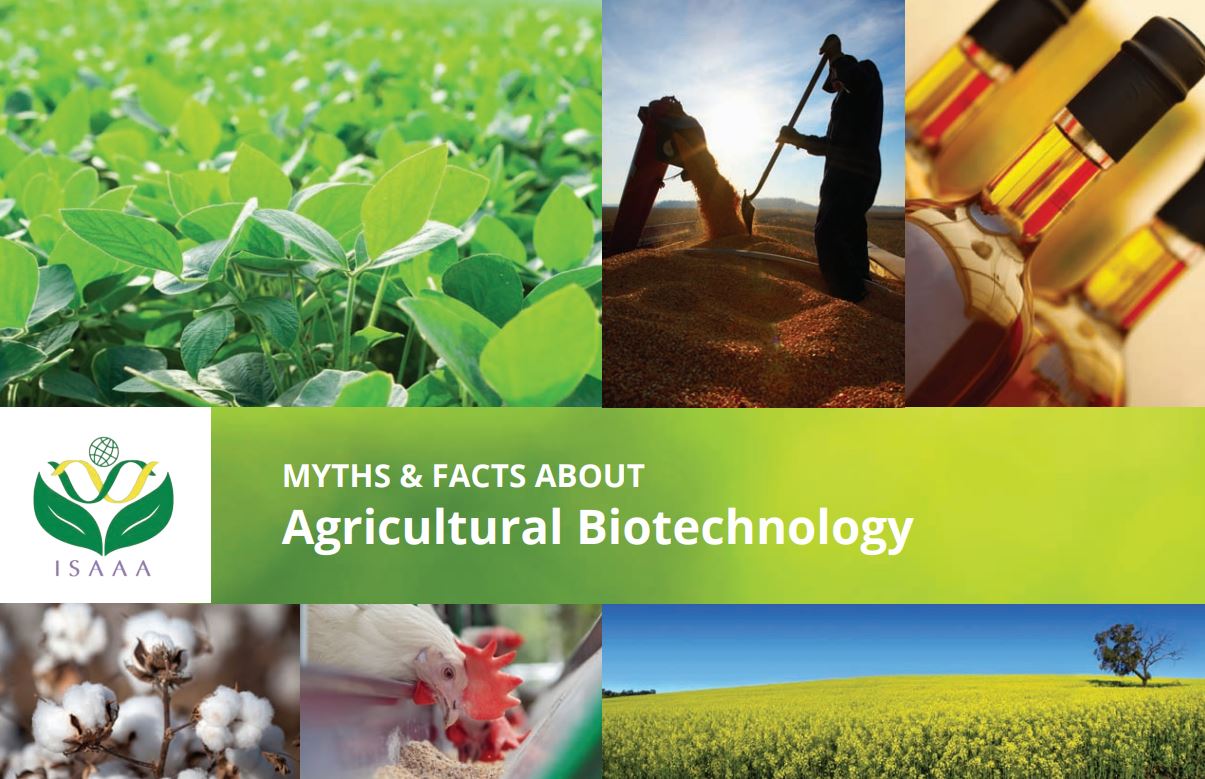ISAAA Answers Top 10 Myths about Agricultural Biotechnology
| |
Since 1996, global agriculture has been engrossed in debates over agricultural biotechnology and genetically modified (GM) crops. This debate includes science, economics, politics, and even religion, and has taken place almost everywhere. It has been going on in research labs, corporate boardrooms, legislative chambers, newspaper editorial offices, religious institutions, schools, supermarkets, coffee shops, and even in private homes.
Scientists who have conducted research on GM crops have attested to the safety of such crops and their contributions to global agricultural productivity and alleviating poverty and hunger. Farmers and their families who have planted biotech crops enjoy their benefits. However, critics believe otherwise, saying GM crops are not likely to help contribute to global food security.
What do you think of this tricky subject? Read on as ISAAA gives the facts behind the top 10 myths about agricultural biotechnology.
MYTH 1: So many resources are devoted to GM crop research. These resources should instead be directed to organic farming or other ecological practices because these practices and crops are proven safe.
FACT: There is no scientific data that proves organic farming to be safer than any other kind of farming. Nor is there data that proves farming GM crops to be unsafe. Farming biotechnology crops actually requires fewer resources than conventional farming.
Organic and biotech farming can contribute solutions to various agricultural problems. Organic production relies on practices, such as cultural and biological pest management, that can include IPM and biological control but excludes the use of synthetic chemicals and GE organisms.
Conventional farming uses pesticides and herbicides to protect crops, but biotechnology farming significantly reduces the use of such chemicals. Farming with biotech crops is sustainable. “GM crops, in general, need fewer field operations, such as tillage, which allows more residue to remain in the ground, sequestering more CO2 in the soil and reducing greenhouse gas emissions.” In 2018, these practices reduced carbon emissions by 23 billion kg, equivalent to removing 15.3 million cars off the road for one year.
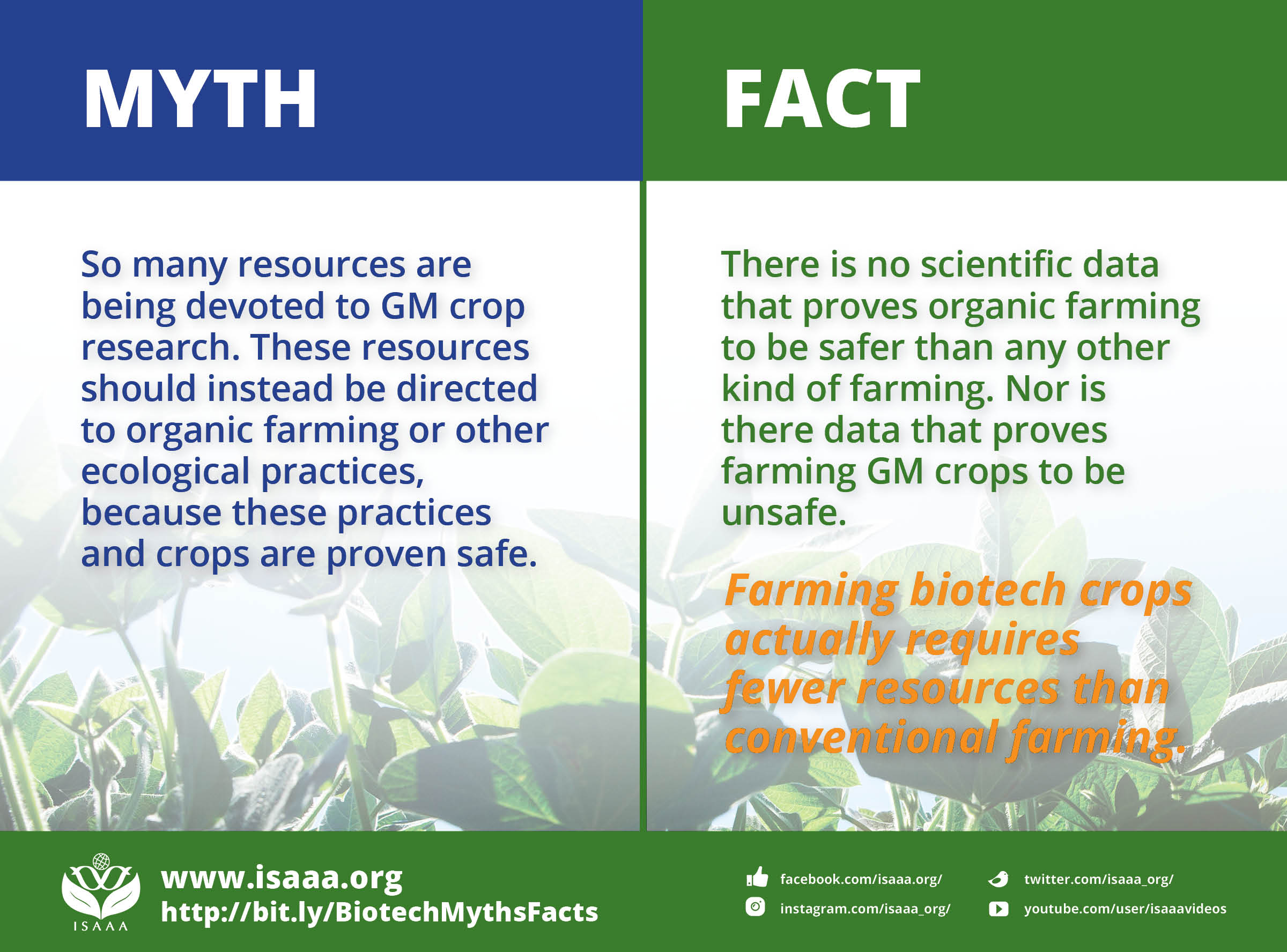
MYTH 2: The genetic engineering of crops is not natural. That type of genetic modification probably does not happen naturally.
FACT: Genetic modification happens naturally. Farmers have been crossbreeding plants for centuries, depending on trial-and-error to get the desired results. Biotechnology is a safer, more deliberate way of achieving—and replicating—the desired results.
Genetic modification is perpetually taking place naturally, even without human intervention. “Most plants reproduce via self-fertilization or movement of genes from one parent to another via pollen. This process is an essential tenet of genetic diversity. But the movement of unwanted genes, naturally occurring or engineered, may result in adventitious presence, a situation where unwanted substances unavoidably are present in production and marketing of agricultural products.”
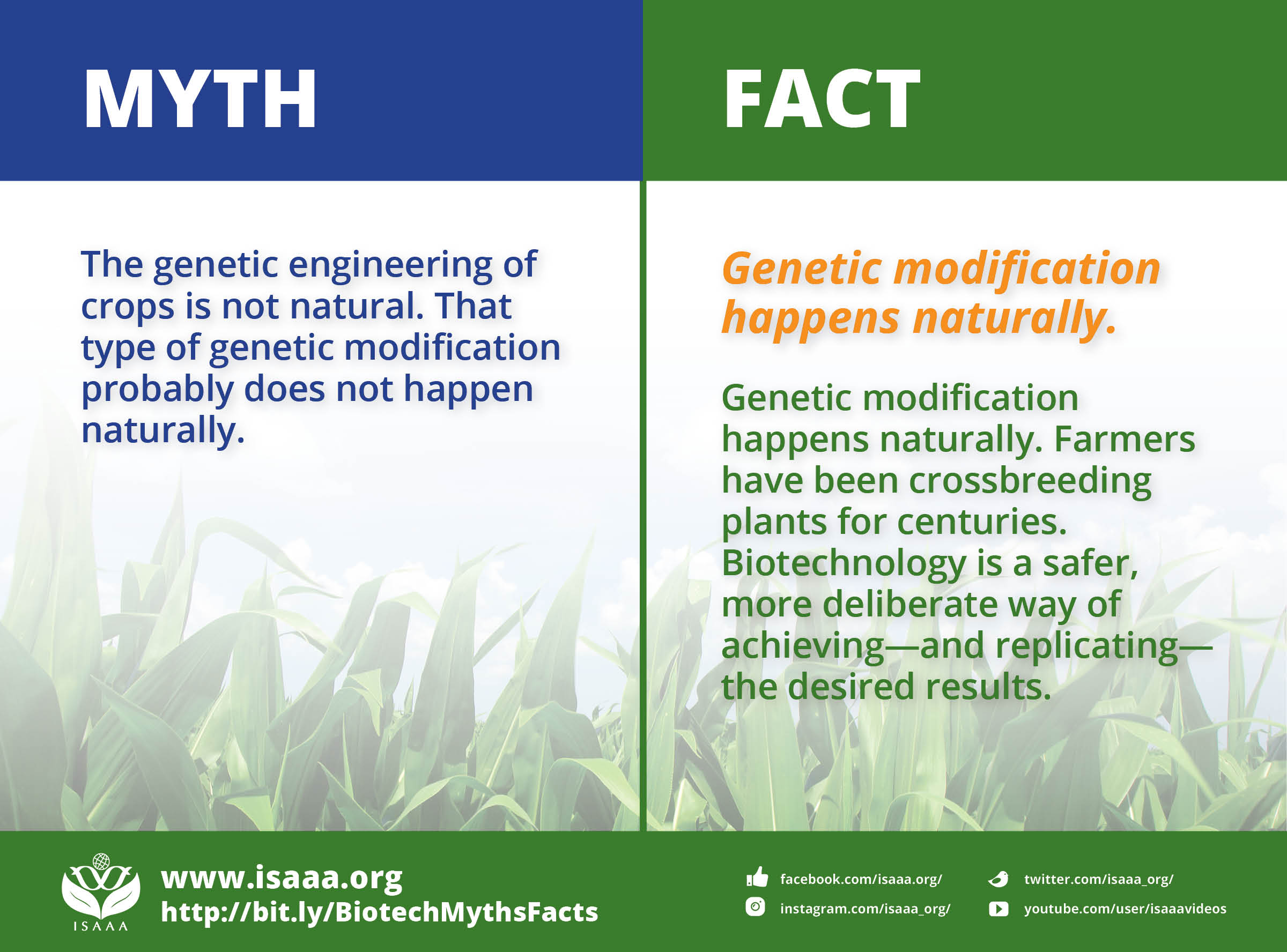
MYTH 3: Field trials of biotech crops are dangerous. There is a high risk of contaminating other crops in nearby fields.
FACT: Field trials are conducted under very strict conditions and follow stringent regulations. These conditions include the prevention of pollen flow and the prevention of entry into food and feed pathways. Failure to comply with any single condition or regulation means the trial will be stopped.
The possibility of unintentional cross-breeding is not unique to biotech crops. Genes move between plants all the time, with both conventional and biotech crops. Field trials conducted in countries all over the world observe strict conditions.
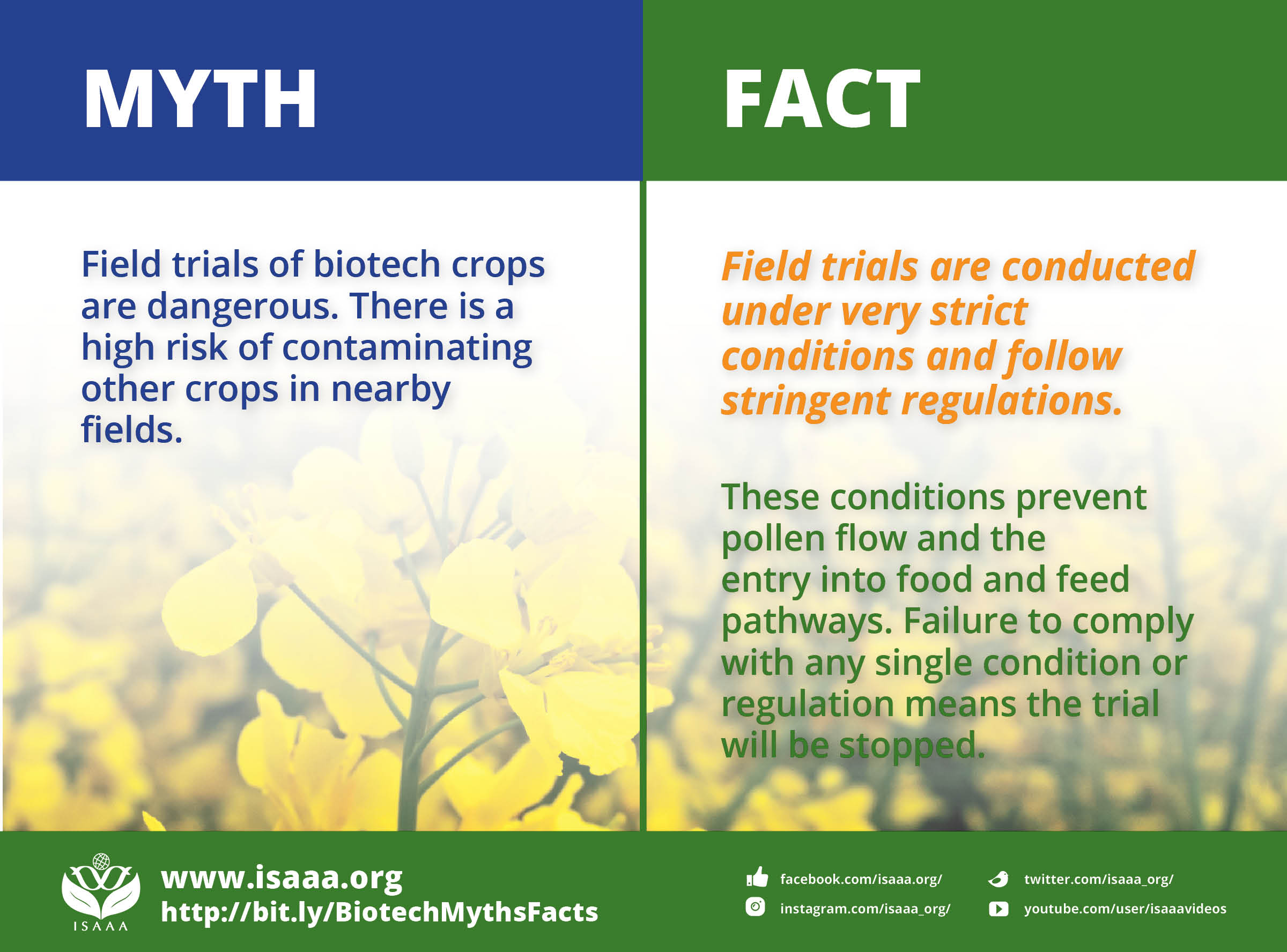
MYTH 4: Field trials of biotech crops are made to appear successful but the results are falsified. Field trials have successful results due to the use of additional fertilizer and less pesticide.
FACT: Field trials are conducted to compare GM crops with non-GM counterparts, and provided similar agricultural management except for the one related to the transgenic trait.
All data from biotechnology crop research—from the research proposal to the field trials—are reviewed, vetted, and signed by panels of technical experts, quarantine officers, project personnel, and Institutional Biosafety Committees (IBC). If any stage of the experiment appears dubious in any way, the experiment is stopped.
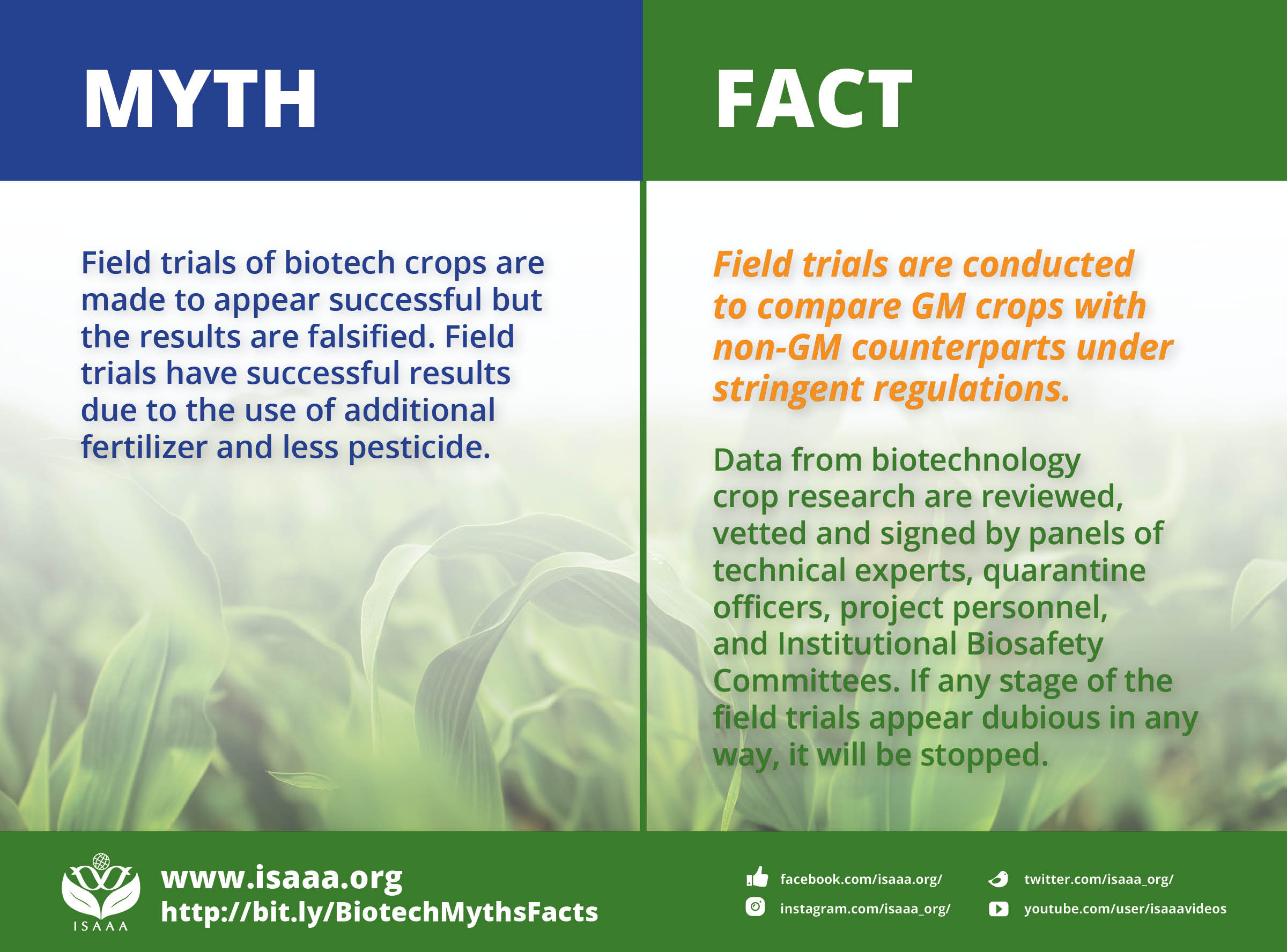
MYTH 5: Planting biotech crops harms the environment. We don’t know what effects these crops will have on the environment in ten or twenty years.
FACT: Current farming practices, including the use of pesticides and herbicides, are very harmful to the environment, and to human health—of farmers and consumers—as well.
Biotech crops that are designed to be pest resistant will significantly reduce the use of pesticides and herbicides, thus reducing the risk to the environment and to human health. Since 1996, biotech crops have reduced the amount of pesticide use. In 2018 alone, fewer insecticide and herbicide sprays reduced carbon emissions by 23 billion kg, equivalent to removing 15.3 million cars off the road for one year.
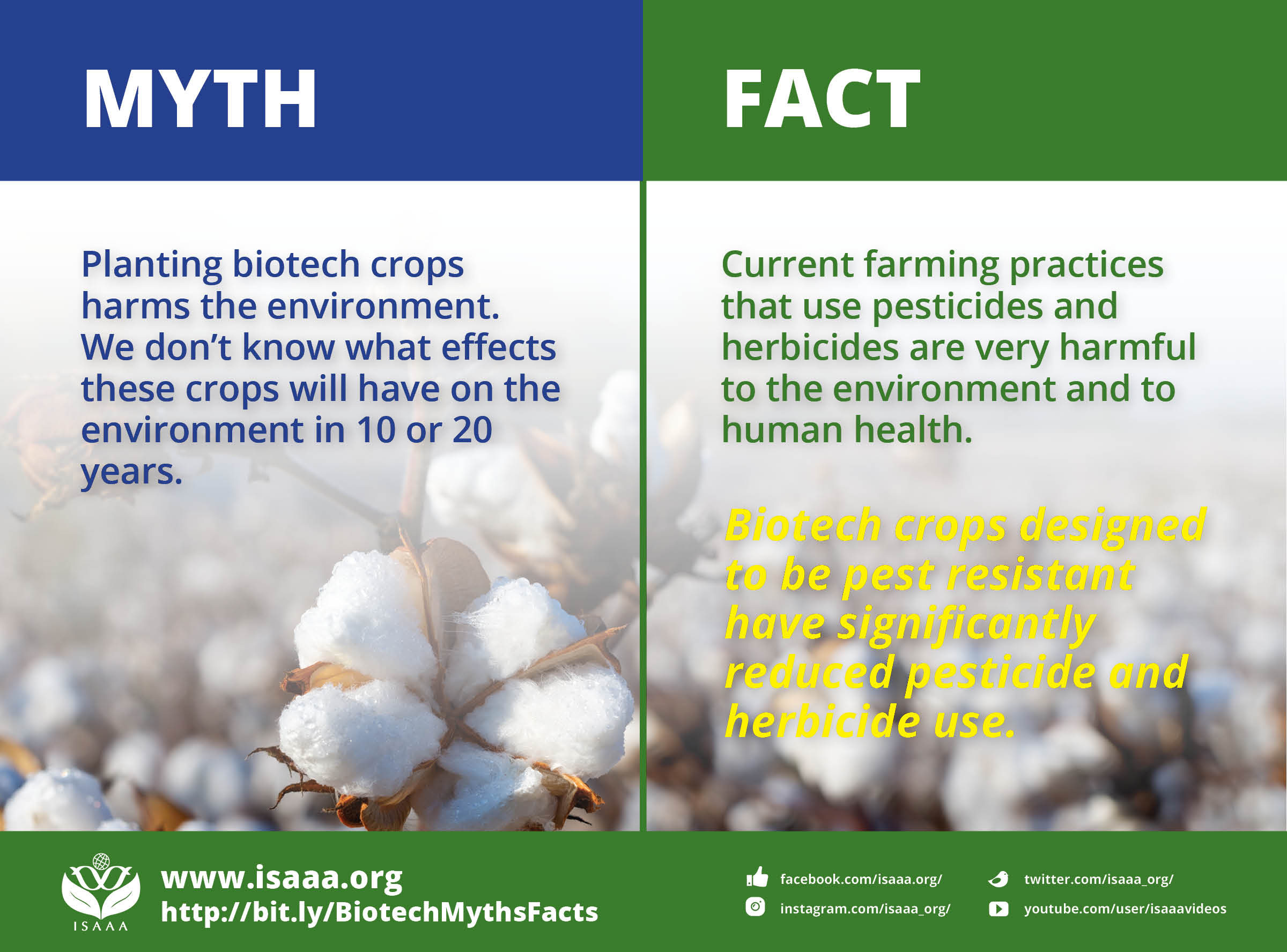
MYTH 6: Seed companies control the sale and use of biotech seeds. They force farmers to buy expensive seeds and sue farmers who plant biotech crops without their permission. Biotech crops just make poor farmers poorer and seed companies richer.
FACT: 95% of the 17 million farmers that grew biotech crops in 2018 are small, resource-poor farmers from developing countries.
The increase in the number of farmers planting biotech crops shows that biotech crops deliver substantial, sustainable, socio-economic, and environmental benefits. In all cases, farmers are given the freedom to choose which types of seeds they wish to plant.
The global area of biotech crops has increased more than 100-fold in 18 years, from 1.7 million hectares in 1996 to 191.7 million hectares in 2018. This makes biotech crops the fastest adopted crop biotechnology in recent history.
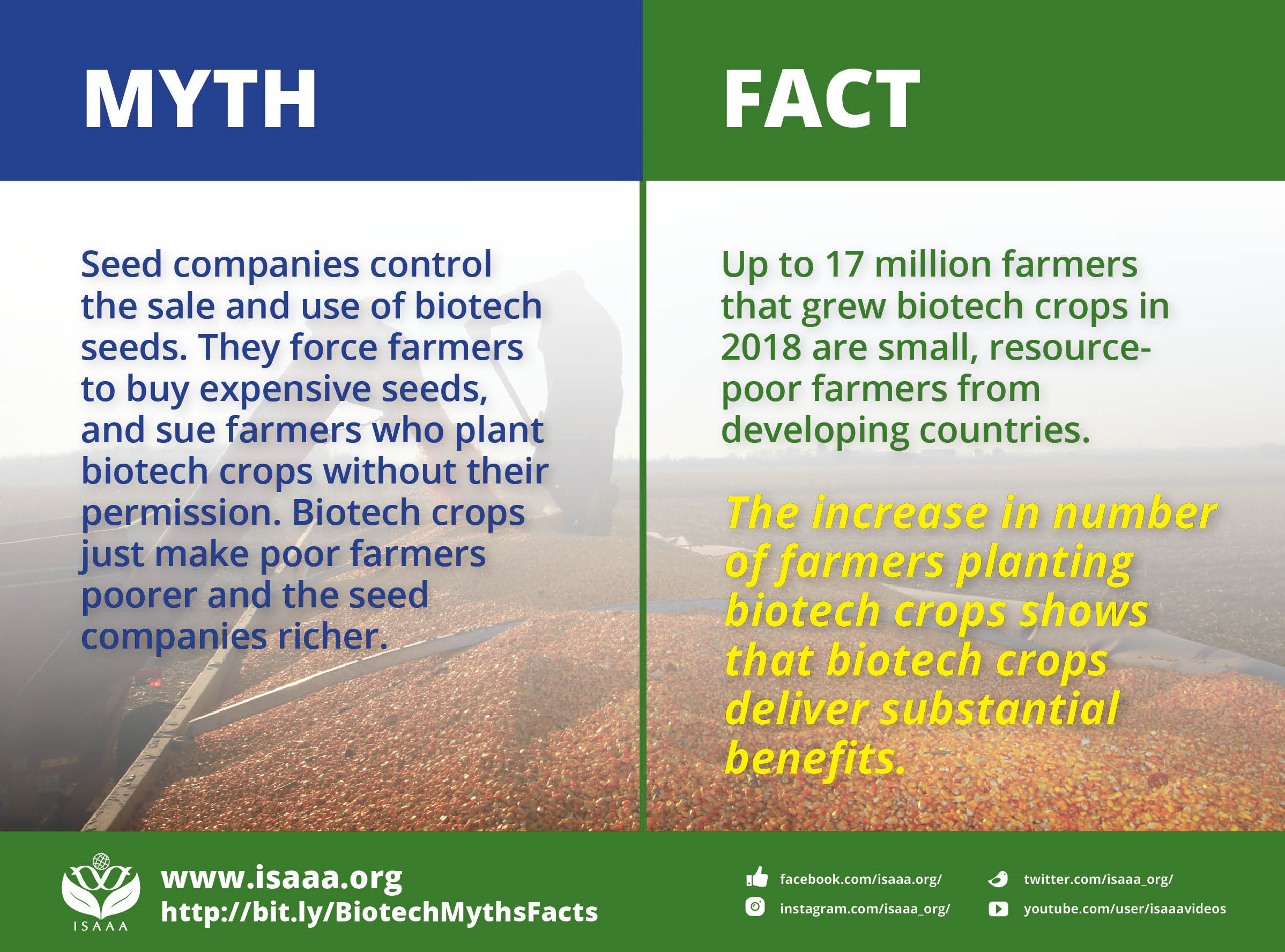
MYTH 7: Biotech crops are responsible for the evolution of “super bugs” and “killer weeds.” Pests and weeds evolve or adapt to overcome the crop’s genetic modification.
FACT: Excessive and irresponsible use of pesticides and herbicides are responsible for the evolution of “super bugs” and “killer weeds.” Adaption of pests and diseases to resistance genes occur in both conventionally-bred and GM lines. Compliance with resistance management helps minimize this phenomenon.
The problem of weeds resistant to herbicides occurs with both traditionally bred and biotech crops. So-called “superweeds” arose because of the overuse of herbicides, or because of movement of conventional herbicide-tolerance traits to weedy species, resulting in plants not controllable with previously applied herbicides.” The overuse of single herbicides can lead to the growth of resistant weeds. As with the insect resistance, alternate modes of action that can be used in rotation will slow resistance development in weeds.
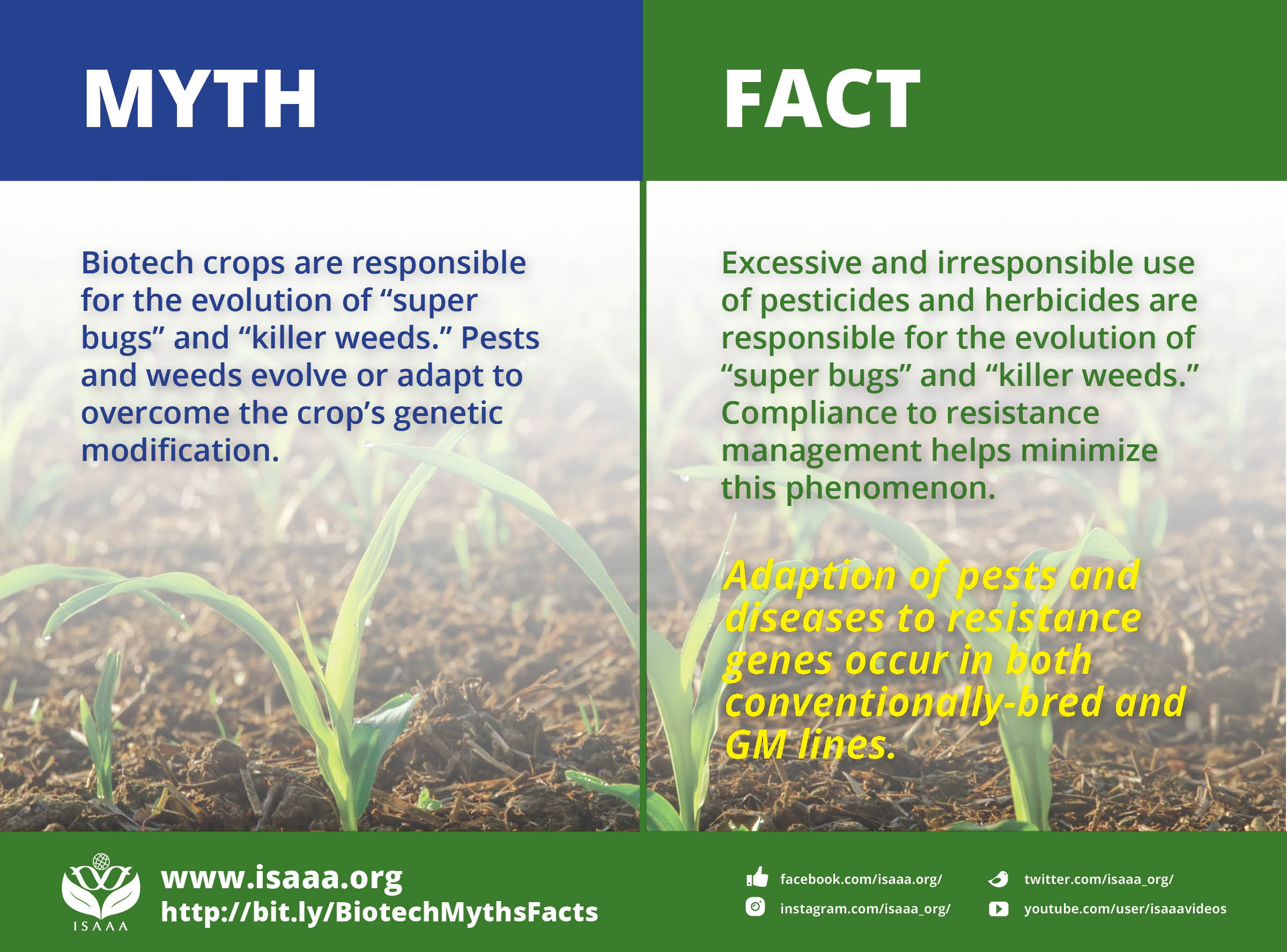
MYTH 8: Foods made with biotech crops are not safe for human consumption. They cause allergies, cancer, homosexuality, and birth defects, as well as many other negative side effects.
FACT: Foods made with biotech crops have been in the market for years, and are as safe as food from traditional crops. Rigorous testing is done on all biotech crops before they are even commercialized. If they have been approved for commercialization then they have been proven safe to eat.
Foods and products made with biotech crops undergo safety testing by the institutions that develop them. From there the data is usually reviewed by agencies with authority to approve them for cultivation or commercialization. The foods and products themselves are also tested rigorously by independent researches, with the results published in peer-reviewed journals to invite additional scrutiny. All products that have been approved for sale on the market undergo “full review by regulatory agencies regarding safety and content” and the process is comparable to the safety assessments performed for pharmaceuticals.
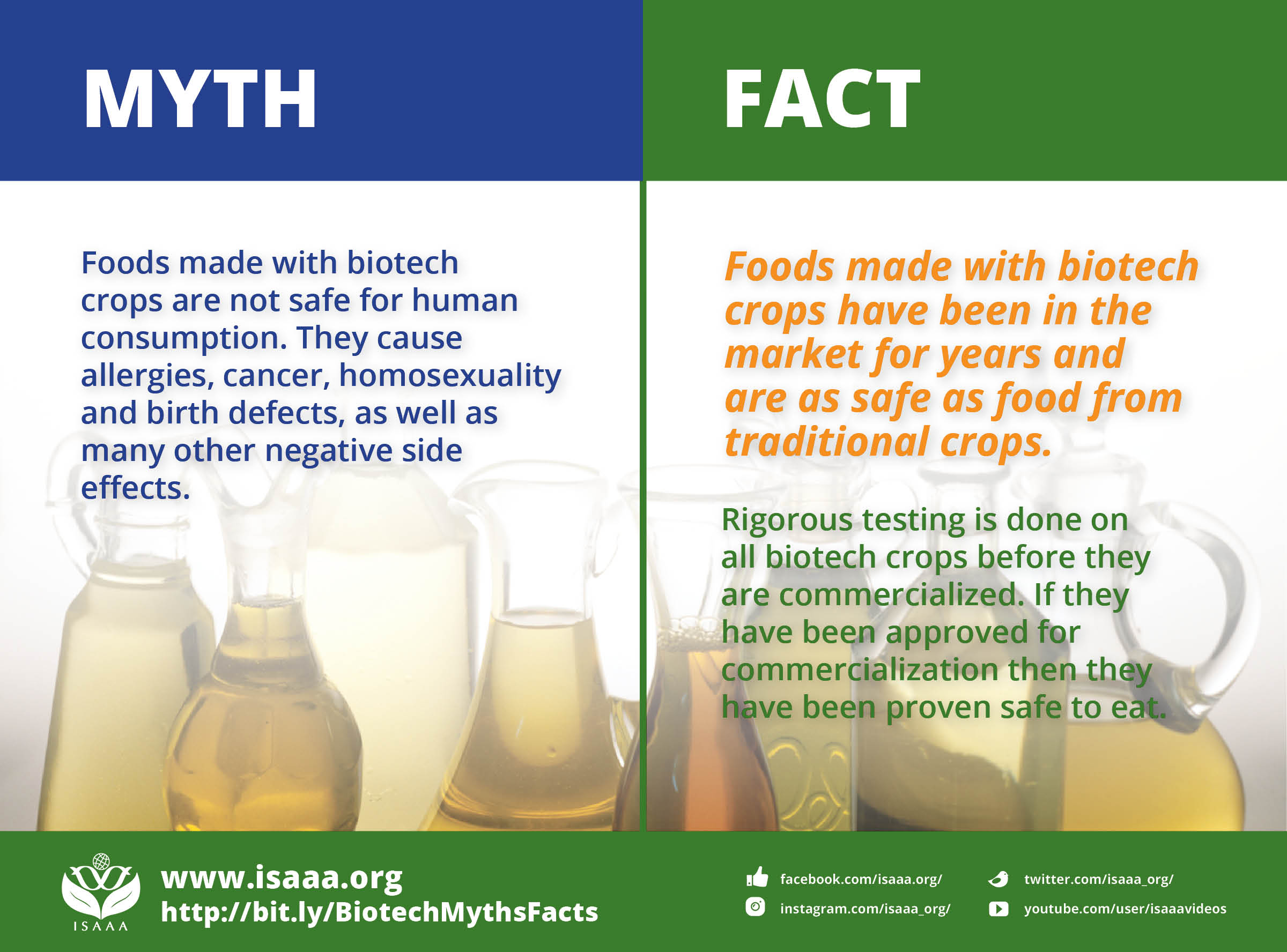
MYTH 9: Biotech crops are not safe for animal consumption either. Farm animals that eat biotech crops get sick and even die. Animals in lab tests were shown to have died from eating biotech foods.
FACT: Biotech crops have been used for feeds for more than 23 years and there is no record of sickness or fatality.
A significant number of studies on biotech crops conducted in the past 10 years focus on their use as food and feed. According to the literature, biotech crops in animal feed are safe for animals and for the humans who consume products derived from those animals.
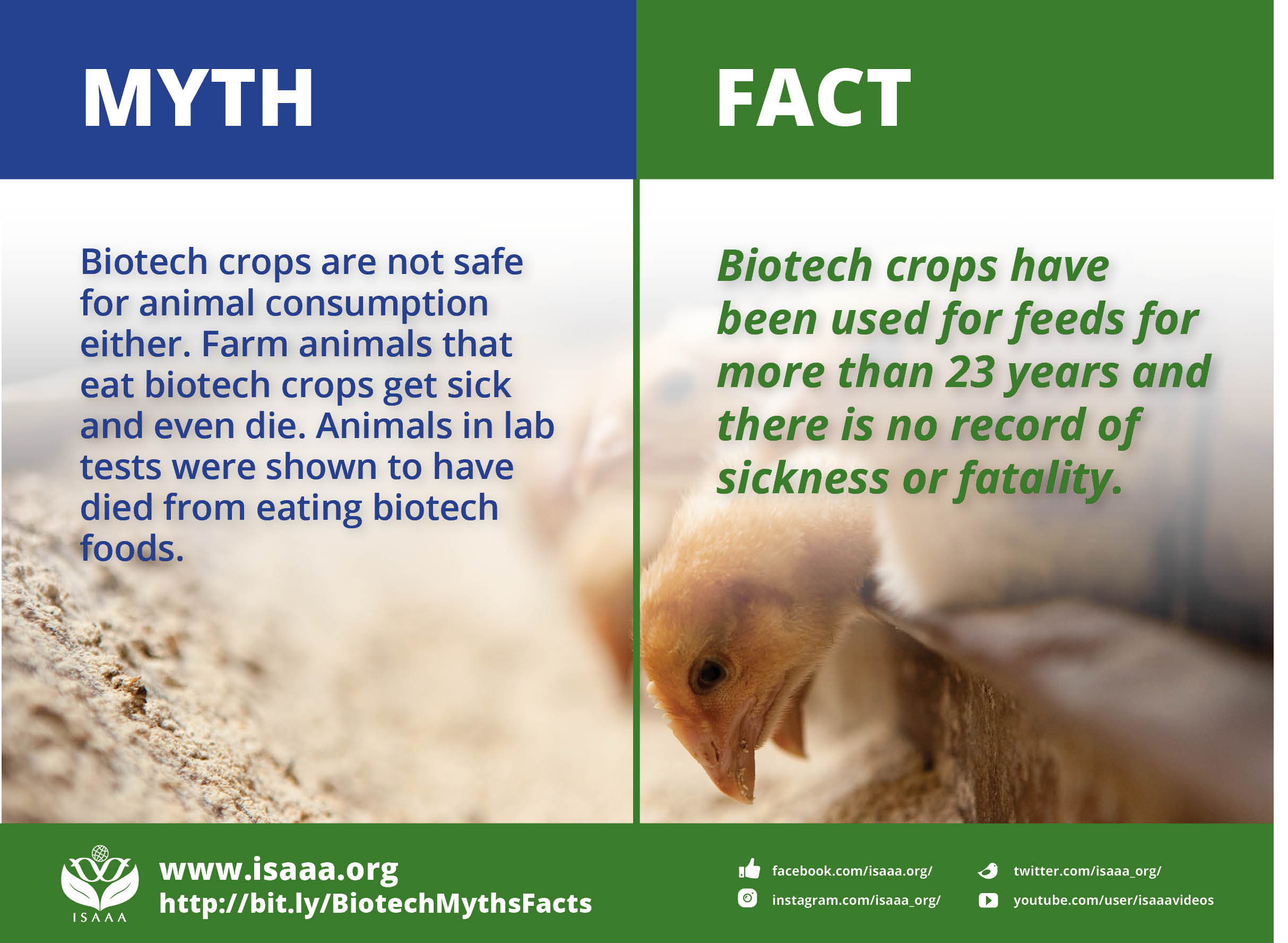
MYTH 10: Nutritionally-enhanced biotech rice and other crops is not the best way to solve the nutrient deficiency problem. Other, more effective solutions are already in place. Micronutrient deficiency is not even a big public health issue anymore.
FACT: Global micronutrient deficiency is a health and nutrition issue that result in susceptibility to infectious diseases, mental retardation, and child mortality.
Nutritionally-enhanced biotech crops are being promoted as a supplementary solution to nutrient deficiency, to be used in conjunction with other methods that are already in place.
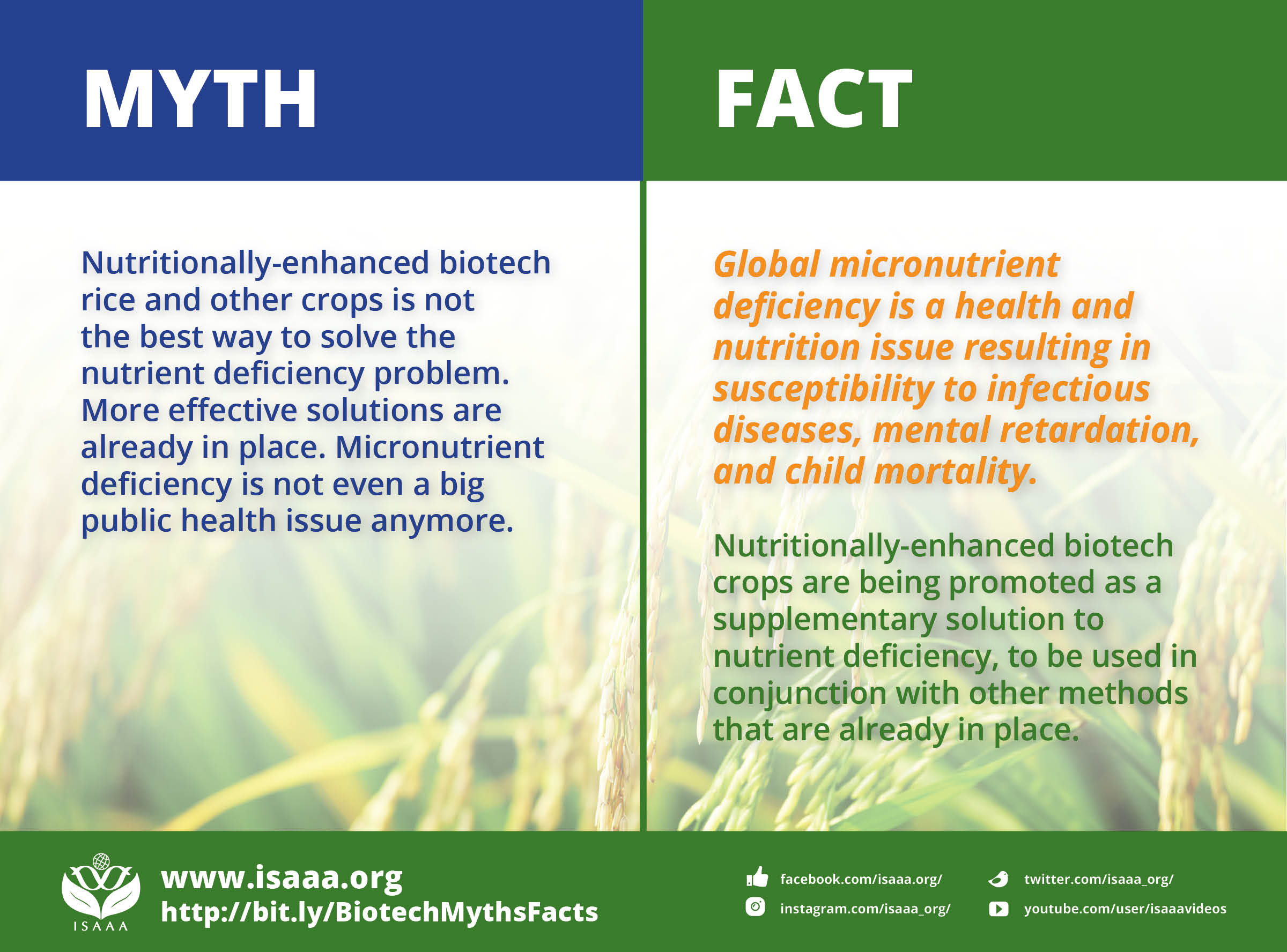
Download and read more details about the facts surrounding the myths in ISAAA booklet Myths & Facts about Agricultural Biotechnology.
| Newer Post | Archive | Older Post |
Science Speaks is ISAAA Inc.'s official blog. Weekly blog articles, authored by ISAAA writers, partners, and invited contributors, aim to help share, disseminate, and promote scientific knowledge and its vital role in achieving global agricultural sustainability and development. Your support to Science Speaks will help us achieve this goal. You can help us by donating as little as $10.


